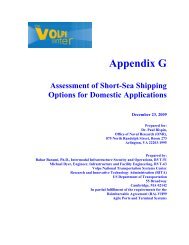ERRV Viking Islay - Marine Accident Investigation Branch
ERRV Viking Islay - Marine Accident Investigation Branch
ERRV Viking Islay - Marine Accident Investigation Branch
- No tags were found...
You also want an ePaper? Increase the reach of your titles
YUMPU automatically turns print PDFs into web optimized ePapers that Google loves.
The 10 minute duration of the ELSA is achieved by means of a reducer/cylinder valvewhich restricts the flow of air from the cylinder to the mask, so that once activated asteady flow of air is provided to the wearer 13 . It is not a demand valve system.The ELSA user instructions state:In general, constant flow escape breathing apparatus is NOT suitable for usewhere:• There are unknown hazards,• There are no planned escape routes,• Escape routes that require physical exertion, e.g. ladders, tunnelsand hatches.No evidence was found that there was any technical fault with the ELSA used in thefatal rescue attempt.1.12.3 Limitations of constant flow EEBDsOne significant disadvantage of the constant air flow arrangement is that it is possiblefor a wearer undertaking particularly strenuous activity to require a greater flow of airthan the EEBD can supply. This might result in the hood collapsing in on the wearer’sface, producing an unpleasant suffocating sensation.It is not widely known that the limitations of the air supply provided by the ELSA (orother similar constant flow type EEBDs) could be exacerbated by a wearer with a highair demand; for example a person with a particularly large tidal volume 14 , or one whoseventilation was increased due to exertion and/or stress.It is also possible that an inadequate air supply could be due to hood volume ratherthan gas flow rate. If the wearer’s tidal volume exceeds that which is available withinthe EEBD hood (due to the difference between the volume of the hood and that of thewearer’s head), the hood could tend to collapse in upon the wearer’s face.1.12.4 Requirement to provide training for EEBDsThe requirement to provide training for EEBDs carried on board ships is given in bothSOLAS and UK legislation 15 . However the content of the training and its degree ofrealism is not prescribed.1.12.5 EEBD training on board <strong>Viking</strong> <strong>Islay</strong>EEBDs were provided for all vessels in the Vroon fleet about 5 years ago, and atraining regime was instigated. Vroon records confirm that the majority of the crewon board <strong>Viking</strong> <strong>Islay</strong> at the time of the accident (including the victim who entered thechain locker wearing EEBD), had received training in June 2006. The training focused13 Manufacturers quote 38 litres per minute.14 The tidal volume of the lungs is the quantity (volume) of air inhaled and exhaled with each normal breath.15 SOLAS Chapter II-2, Regulation 15, paragraph 2.2.2: Training in the use of the EEBDs shall be consideredas part of onboard training. Also in UK legislation: SI 2003 No.2951. The Merchant Shipping (FireProtection) Regulations (Amendment) 2003. Training in the use of EEBDs shall be included in the onboardtraining of each crew member as soon as possible…after he first joins the ship.21
















